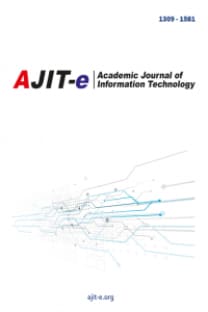Bayes Ağları ile Tüp Bebek Tedavi Sürecinde Blastosist Skoru Tahmini
Bayesian Network Modeling of IVF Blastocyst Score Prediction
In-vitro fertilization, Predicting blastocyst development, Bayesian networks Parameter learning, Frequency estimates,
___
Blank, C., DeCroo, I., Weyers, B., van Avermaet, L., Tilleman, K., van Rumste, M., de Sutter, P., Mischi, M., & Schoot, B. C. (2020). Improvement instead of stability in embryo quality between day 3-5: A possible extra predictor for blastocyst selection. European Journal of Obstetrics and Gynecology and Reproductive Biology, 253, 198–205. https://doi.org/10.1016/j.ejogrb.2020.08.027Cheng, J., Greiner, R., Kelly, J., Bell, D., & Liu, W. (2002). Learning Bayesian networks from data: An information-theory based approach. Artificial Intelligence, 137(1–2), 43–90. https://doi.org/10.1016/S0004-3702(02)00191-1
Csató, L., & Reiz, B. (2008). Tree-like Bayesian Network classifiers for surgery survival chance prediction. In Article in International Journal of Computers: Vol. III. https://www.researchgate.net/publication/228634935
Dessolle, L., Fréour, T., Barrire, P., Daraï, E., Ravel, C., Jean, M., & Coutant, C. (2010). A cycle-based model to predict blastocyst transfer cancellation. Human Reproduction, 25(3), 598–604. https://doi.org/10.1093/humrep/dep439
Friedman, N., Geiger, D., & Goldszmidt, M. (1997). Bayesian Network Classifiers. Machine Learning, 29(2–3), 131–163. https://doi.org/10.1023/a:1007465528199
Gardner, D. K., Lane, M., Stevens, J., Schlenker, T., & Schoolcraft, W. B. (2000). Blastocyst score affects implantation and pregnancy outcome: towards a single blastocyst transfer. Fertility and Sterility, 73(6), 1155–1158. https://doi.org/10.1016/S0015-0282(00)00518-5
Gardner, D. K., Surrey, E., Minjarez, D., Leitz, A., Stevens, J., & Schoolcraft, W. B. (2004). Single blastocyst transfer: A prospective randomized trial. Fertility and Sterility, 81(3), 551–555. https://doi.org/10.1016/j.fertnstert.2003.07.023
Gerris, J., & De Neubourg, D. (n.d.). Single embryo transfer after IVF/ICSI: present possibilities and limits.
Greiner, R., Su, X., Shen, B., & Zhou, W. (2005). Structural extension to logistic regression: Discriminative parameter learning of belief net classifiers. Machine Learning, 59(3), 297–322. https://doi.org/10.1007/s10994-005-0469-0
Heckerman, D. (2020). A Tutorial on Learning With Bayesian Networks. Studies in Computational Intelligence, 156, 33–82. http://arxiv.org/abs/2002.00269
Irmawati, Basari, & Gunawan, D. (2019). Automated Detection of Human Blastocyst Quality Using Convolutional Neural Network and Edge Detector. 2019 1st International Conference on Cybernetics and Intelligent System, ICORIS 2019, 181–184. https://doi.org/10.1109/ICORIS.2019.8874925
Kohavi, R., Langley, P., & Yun, Y. (n.d.). The Utility of Feature Weighting in Nearest-Neighbor Algorithms.
Lucas, P. J. F. (2004). Restricted Bayesian Network Structure Learning (pp. 217–234). Springer, Berlin, Heidelberg. https://doi.org/10.1007/978-3-540-39879-0_12
Martikainen, H., Orava, M., Lakkakorpi, J., & Tuomivaara, L. (2004). Day 2 elective single embryo transfer in clinical practice: Better outcome in ICSI cycles. Human Reproduction, 19(6), 1364–1366. https://doi.org/10.1093/humrep/deh197
Meloni, A., Ripoli, A., Positano, V., & Landini, L. (2009). Mutual information preconditioning improves structure learning of bayesian networks from medical databases. IEEE Transactions on Information Technology in Biomedicine, 13(6), 984–989. https://doi.org/10.1109/TITB.2009.2026273
Mladenić, D., & Grobelnik, M. (2003). Feature selection on hierarchy of web documents. Decision Support Systems, 35(1), 45–87. https://doi.org/10.1016/S0167-9236(02)00097-0
Papanikolaou, E. G., Kolibianakis, E. M., Tournaye, H., Venetis, C. A., Fatemi, H., Tarlatzis, B., & Devroey, P. (2008). Live birth rates after transfer of equal number of blastocysts or cleavage-stage embryos in IVF. A systematic review and meta-analysis. Human Reproduction, 23(1), 91–99. https://doi.org/10.1093/humrep/dem339
Steptoe, P. C., & Edwards, R. G. (1978). Birth after the reimplantation of a human embryo. In Lancet (Vol. 2, Issue 8085, p. 366). Lancet. https://doi.org/10.1016/s0140-6736(78)92957-4
Su, J., Zhang, H., Ling, C. X., & Matwin, S. (2008). Discriminative parameter learning for Bayesian networks. Proceedings of the 25th International Conference on Machine Learning, 1016–1023. https://doi.org/10.1145/1390156.1390284
Thurin, A., Hausken, J., Hillensjö, T., Jablonowska, B., Pinborg, A., Strandell, A., & Bergh, C. (2004). Elective Single-Embryo Transfer versus Double-Embryo Transfer in in Vitro Fertilization. New England Journal of Medicine, 351(23), 2392–2402. https://doi.org/10.1056/nejmoa041032
Uyar, A., Bener, A., Ciray, H. N., & Bahceci, M. (2010). Bayesian networks for predicting IVF blastocyst development. Proceedings - International Conference on Pattern Recognition, 2772–2775. https://doi.org/10.1109/ICPR.2010.679
Veleva, Z., Vilska, S., Hydén-Granskog, C., Tiitinen, A., Tapanainen, J. S., & Martikainen, H. (2006). Elective single embryo transfer in women aged 36-39 years. Human Reproduction, 21(8), 2098–2102. https://doi.org/10.1093/humrep/del137
Vivencio, D. P., Hruschka, E. R., Do Carmo Nicoletti, M., Dos Santos, E. B., & Galvão, S. D. C. O. (2007). Feature-weighted k-nearest neighbor classifier. Proceedings of the 2007 IEEE Symposium on Foundations of Computational Intelligence, FOCI 2007, 481–485. https://doi.org/10.1109/FOCI.2007.371516
Zhan, Q., Sierra, E. T., Malmsten, J., Ye, Z., Rosenwaks, Z., & Zaninovic, N. (2020). Blastocyst score, a blastocyst quality ranking tool, is a predictor of blastocyst ploidy and implantation potential. F&S Reports, 1(2), 133–141. https://doi.org/10.1016/j.xfre.2020.05.004
- Yayın Aralığı: 4
- Yayıncı: AKADEMİK BİLİŞİM ARAŞTIRMALARI DERNEĞİ
Bayes Ağları ile Tüp Bebek Tedavi Sürecinde Blastosist Skoru Tahmini
Asli UYAR, Yasemin ATILGAN ŞENGÜL
Endüstri 5.0’a Doğru: Zeki Otonom Sistemlerde Etik Ve Ahlaki Sorumluluklar
Pelin CANBAY, Zübeyde DEMİRCİOĞLU
Duygu FINDIK COŞKUNÇAY, Şule ERDİLMEN
Merkezi Sınavlardaki Soru Kitapçıklarına A* Algoritması ile Derslerin Yerleştirilmesi
Akıllı Ev Sistemleri Üzerine Bir Model Önerisi
Fatih İLKBAHAR, Şeyma ÜNAL, Armağan Tuğçe KARAKAYA, Bayram EREN
